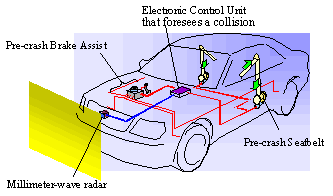Jun. 27, 2002
Toyota Develops "Pre-crash Safety" System
-Injury-reducing Technology Due in New Models Next Year-
TOKYO ― TOYOTA MOTOR CORPORATION (TMC) announced today that it has developed "Pre-crash Safety," an innovative system that reduces collision injury by foreseeing unavoidable collisions to preemptively activate safety devices. Toyota plans to install this system in new vehicle models that will be introduced next year.
Pre-crash Safety consists of three elements. The Pre-crash Sensor uses millimeter-wave radar to sense vehicles and obstacles on the road ahead, and an Electronic Control Unit (ECU) to determine whether or not a collision is imminent based on the position, speed and traveling course of the object. The Pre-crash Seatbelt increases passenger-restraint performance by retracting the seat belt in advance, immediately after an unavoidable collision is identified. The Pre-crash Brake Assist reduces collision speed by providing increased braking force early on and in accordance with brake pedal operation by the driver.
The key to lessening collision injury is to foresee collisions as soon as possible and to preemptively activate safety devices to increase their effectiveness. Until now, safety devices were made to activate only after a collision occurred. Activating them in advance requires that an unavoidable collision be anticipated. The newly developed Pre-crash Sensor makes it possible to foresee a collision and activate safety devices well ahead of impact.
Pre-crash Sensor
The Pre-crash Sensor offers enhanced object-position recognition using millimeter-wave radar, which possesses excellent object-recognition performance even in inclement weather such as rain or snow, and an electronic scanning method. Furthermore, a compact design ensures that the Pre-crash Sensor can be installed in vehicles easily.
Additionally, newly developed ECU software determines whether or not a collision is imminent based on the expected traveling course of the vehicle estimated from the driver's operation, as well as the position, speed and expected traveling course of not only a preceding vehicle but also an oncoming vehicle and of other obstacles.
Pre-crash Seatbelt
In addition to a seatbelt with a conventional pretensioner, which retracts the seatbelt immediately following a collision, the Pre-crash Seatbelt reduces collision injury by eliminating seatbelt slack before the collision, thus restraining the driver/passenger at an earlier stage.
Pre-crash Brake Assist
Conventional Brake Assist generates a greater braking force after judging that emergency braking has occurred when the brake pedal has been depressed rapidly. In contrast, once the Pre-crash Sensor determines that a collision is unavoidable, Pre-crash Brake Assist immediately activates as soon as the driver steps on the brake pedal and in accordance with the degree to which the pedal is depressed. This increases braking force well in advance of a collision, thus reducing the collision speed.

Using a radar, the system determines whether or not a collision is imminent based on the position, speed, and traveling course of the object.







